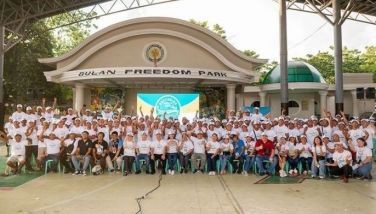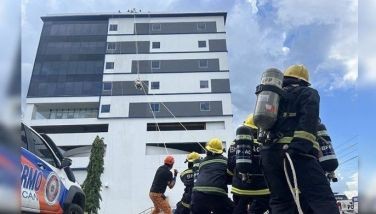NFA blots P-Noy’s honesty image

Our country’s favorable image abroad hangs by a thread… it’s based on P-Noy’s reputation for reform and honesty. P-Noy must have had this great responsibility in mind when he appointed another de facto Agriculture Secretary with powers over the National Food Authority or NFA. He surely must know enough about the goings on at NFA that made him effectively castrate Agriculture Secretary Proceso Alcala.
P-Noy finds it hard to fire people he once trusted enough to appoint to high office. He didn’t have the heart to fire Alcala so he sent out a broad hint of his displeasure by appointing Kiko Pangilinan to effectively be the other Agriculture Secretary. He than gave Kiko control over the agencies that matter in the department including those on top of rice and coconut. Cleaning up the NFA is now Kiko’s headache.
My colleague at the Opinion page, Jarius Bondoc just revealed what looks like a billion peso overprice in the trucking services for the recently imported rice stock from Vietnam. If Kiko is sniffing out where massive corruption at NFA is, Jarius gave him a good place to start looking.
According to Jarius, corruption is “embedded in the contract for the first 200,000 tons to be delivered before month’s end.†The deal is for a total of $439 per ton, which Jarius explains, “includes a ‘tong-pats’ (kickback) of $30 per ton.†Jarius reports that NFA “has assigned the hauling to a favored firm in Manila. Cargo handling is more than double the usual rate. There’s kickback of P1.08 billion, NFA insiders murmur.â€
That’s just in the hauling. What about the price of the rice itself. Why bid out such a large volume at once, 800,000 metric tons, at a time when international rice prices are expected to go down as these are going down now?
Delivery of the rice will be in staggered basis anyway. Wouldn’t it make more sense to price the rice based on international prices on delivery date? Pegging the price right away for all 800,000 metric tons may just peg our price at a level higher than it should be. Besides, NFA said the importation is for buffer stock which suggests not for immediate need.
Google international rice prices and you can come out with these facts: “Thailand 5 percent broken rice today (May 1, 2014) quoted at about $375 per ton, down about $5 per ton from a week ago, down about $10 per ton from a month ago and down about $160 per ton from a year ago.
“Vietnam five percent broken rice today shown at about $390 per ton, unchanged from a week and a month ago, up about $10 per ton from a year ago.â€
The same googled source reports that “The National Food Authority (NFA) of the Philippines awarded contracts to supply 800,000 tons of 15 percent broken well-milled white rice to two of Vietnam’s state-owned companies. http://www.oryza.com/reports/oryza-wri/oryza-white-rice-index- percentE2 percent80 percent93-index-hovers-around-450-ton-impact-el-ni percentC3 percentB1o-be-blunted
According to the Official Gazette, “The rice contracted by NFA is long grains white rice well-milled with 15 percent brokens. VINAFOOD II will supply 600,000 metric tons at $436.50 per metric for 200,000 MT for Lot 1, $437.75 per metric ton for 200,000 MT for Lot 2, and $439.25 for 200,000 MT for Lot 3. Meanwhile, VINAFOOD I will supply the remaining 100,000 metric tons, with a bid of $436 for Lot 1 and $439 per metric ton for another 100,000 metric tons for Lot 2.â€
Hmm… how come the published international price for Vietnamese five percent broken is pegged at $390 per metric ton and we bought 15 percent broken at $436.50? Maybe that’s the overprice in local handling that Jarius was talking about. And why buy Vietnamese when the Thais are selling five percent broken at $375/ton. One more thing… hindi ba… the more broken, the price should be cheaper?
The not so funny thing is that the Official Gazette justified the NFA buying price saying “the NFA was able to save on its budget because all the prices offered were lower than the approved $477.28 per metric ton.†Come on guys... Show savings against prevailing international price and not against a price NFA itself budgeted or set. Bobolahin pa tayo and it is all in the Official Gazette.
One other possibility which the NFA is also not telling us is that this importation isn’t really for buffer stock but partly panic buying. If these are for buffer stock, that means we are not in a hurry and can wait for the prices to go down.
International prices are certain to go down because there is a world over supply. And Thailand is set to dump their hoard from a controversial rice buying project that drained the Thai government coffers and helped bring down the Yingluck Shinawatra government.
Most likely, NFA is in a worse stock situation than is politically tenable to admit. The fact that the price of rice has been escalating in the local market for months now seems to indicate a tightening of supply and NFA does not have sufficient stock to release to calm the market down.
There is an interesting study by PIDS, a government economic think tank that explains what is going on. The article’s interesting kicker head: “Bakit nagmahal ang bigas noong 2013? At bakit mahal pa rin?â€
The short answer to that question is: somehow, someone goofed. Someone promised P-Noy rice self sufficiency last year, failed to deliver and also failed to import enough to cover the shortfall. Basic law of supply and demand at work here, the PIDS study authors wrote… low supply, high prices.
Here is how the study authors traced the problem of high local rice prices: “The rice price spike experienced in the third quarter of 2013 alarmed the public. The retail price of rice shot up to P36.28 in December from P32.37 in June 2013, or a 12-percent increase in six months.
“Speculations spread about the cause of the spike, the most popular of which was the hoarding by private traders. The Department of Agriculture (DA) Secretary himself has been quoted as blaming rice cartels for price manipulation.
“These cartels were perceived to be in connivance with rice smugglers in an unholy alliance. It is easy to blame rice traders and smugglers for price manipulation, but it is another thing to produce evidence for this accusation. Price manipulation would entail restriction of supply from all sources, including from outside the country, which is not exactly consistent with the problem of rampant smuggling in the imagination of the public.â€
Oo nga naman. We may even owe the rice smugglers an apology. If it were not for them, the price of rice in our local markets would have been even higher, thanks to NFA and DA incompetence.
The PIDS study traces the problem to the inadequacy of supply starting from mid-2013 attributed to the reduction in imports due to government policy. “Such reduction was neither compensated by a commensurate increase in domestic production nor by a timely release from the buffer stock.â€
The study explains what happened: “Comparing National Food Authority (NFA) and Bureau of Agricultural Statistics-Philippine Statistics Authority data for 2012, imports fell by 638,000 tons in 2013. This drop was in line with the goal of the DA’s Food Staples Sufficiency Program (FSSP). This program sought a target of 100-percent rice self-sufficiency by the end of 2013 by raising domestic production and curbing imports.
“However, production targets were set at unreasonably high levels to achieve self-sufficiency by 2013. The palay production target for 2013 was 20 million tons of paddy from a target of 18.5 million tons in 2012. Since 2012, however, actual palay production fell far short of the target. While palay production did hit 18.44 million tons in 2013, up from 18.03 million tons, the increment of 439,000 tons (or an equivalent of 287,000 tons of milled rice) was not enough to counter the effects of the reduction in imports.â€
Reforms at the NFA have long been sought. Studies upon studies have been made to make the mission of NFA clear and save the taxpayers a lot of wasted money running into the billions of pesos every year.
But as Dr. Rolando Dy, the agri-business expert at the University of Asia and the Pacific puts it, “no decision is a bad decision. NFA is such an unfortunate example. There is a wide array of past analytics and experts opinions, but little action. This is reflective of Filipino procrastination and fear. Doing what is right for the nation is sacrificed for political and economic imperatives.â€
In the meantime, the crooks in the agency make a mockery of P-Noy’s Daang Matuwid. If such corruption and incompetence is allowed under P-Noy’s watch, we have lost the only thing we have going for us in the eyes of the world: P-Noy’s reputation for honesty in governance.
Boo Chanco’s e-mail address is bchanco@gmail.com. Follow him on Twitter @boochanco
- Latest
- Trending


























